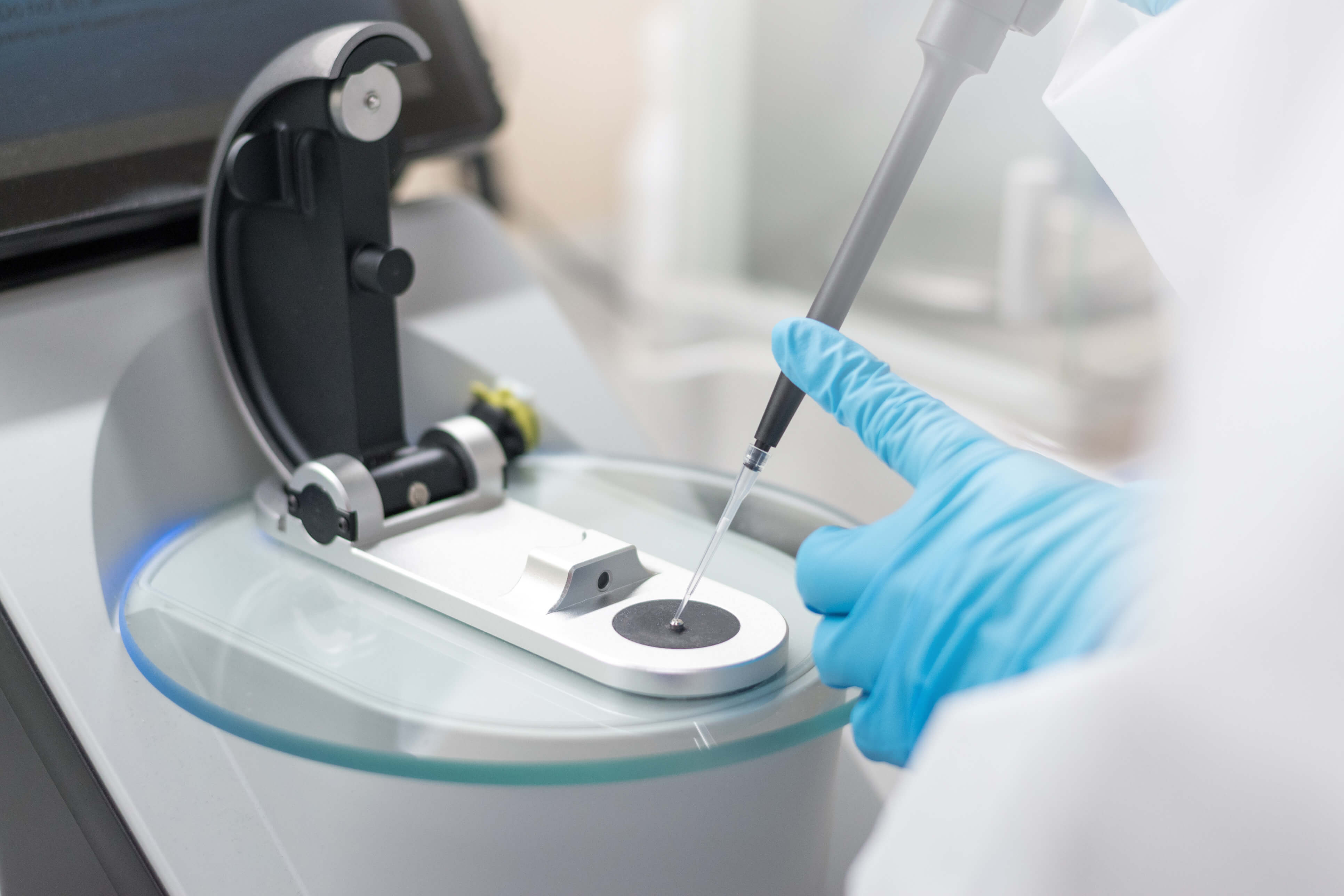Headline
Add text here
Headline
Add text here
Add text here
Add text here

What are the steps you should take prior to purchasing a LIMS solution? We review the planning and evaluation actions to take prior to your investment in a LIMS.

The first consideration in purchasing a LIMS is determining the type of system best for your laboratory. There are three environments to consider:
To choose the appropriate type of system you need, consider the number of locations your lab works with, the type of customers you serve, the budget that you’re working with, and the processes that the LIMS will be documenting.
Self-hosted vs. cloud-hosted platforms vary in total costs: Regarding fees, a self-hosted system requires an initial license fee, compared to cloud-hosted platforms that offer an annual subscription to the service. You can also use a total cost of ownership calculator to compare the differences between these two types of LIMS systems, including costs for training, upgrades, and support.
It’s also important to weigh the type of system you’ll want to implement with the success metrics to analyze the LIMS:

The LIMS environment that you choose, self-hosted, PaaS, or SaaS, will influence the total cost of the system. Consider these factors and understand how they interact with the LIMS setup of your choice.
The key to solid lab infrastructure is access. Labs can’t run efficiently if there are not enough access points for all employees. Laptops, desktop computers, and tablets all have to be in the proper locations where the work is actually conducted. If staff must walk away from their workstation every 5 minutes, even the best and brightest can easily forget the specifics of the documentation.
Laboratory deployed equipment must also be considered. The location of barcode readers and printers must be conveniently placed. If the lab is working with heavy-duty solvents, solvent-resistant hardware may need to be purchased.
In order to avoid compliance problems and human error, documentation should be completed at the time that the lab work is being executed, with little to no lag time in between tasks. PaaS and SaaS LIMS allow for multiple access points, which helps streamline documentation. An self-hosted LIMS may work well with a single or centralized laboratory, offering your team ultimate control on its setup.
A self-hosted arrangement for IT infrastructure gives complete control of the process to the organization. This means that the organization is responsible for the major capital expense of building and configuring servers. In addition to the initial expenses, you will need a dedicated IT team with specific expertise to maintain upgrades, maintenance, and managing system issues.
If you don’t have an internal IT team, PaaS and SaaS often include IT management in the subscription, reducing the financial risk of managing your infrastructure needs and allowing your team to spend more focus on the lab’s business. PaaS infrastructure is scalable, meaning your lab can reduce or increase server capacity based on the lab’s current needs. SaaS systems will scale on usage without the need for active management of the IT infrastructure. For both PaaS and SaaS, backups and recoveries have already been built into the system.
The Step-by-Step Guide to Purchasing a LIMS8Self-hosted: Typically perpetual licensingPaaS: Perpetual licensing or subscriptionSaaS: Subscription onlyThe decision regarding a perpetual or subscription model is based on how long your organization wants to keep the LIMS running and how important known and predictable costs are. A major factor in this determination is a financial one. Perpetual licensing of an self-hosted arrangement is a capital expenditure, locking you into one cost for the length of the agreement. Although expensive initially, over a long-term agreement, you may realize cost savings.
In PaaS, the software licensing is achieved through either perpetual arrangement or subscription. Infrastructure licensing is generally subscription-based. Customization is possible, but it is paid on an as needed basis.
With a SaaS-based laboratory information management system, all licensing is subscription-based as an operational expenditure. A complete subscription-based service can mean lower total costs if your lab wants a less customized solution and is willing to adopt industry best practice.
With a self-hosted LIMS, you are responsible for determining requirements and mapping of process flows. Because of the amount of individual specifications, it may take a longer time to configure, validate and deploy a self-hosted LIMS.
A PaaS LIMS will give your lab opportunities for customizations, creating a hybrid system that is not extensively involved in the IT setup. Upgrades are handled on an ad-hoc basis.
Implementing a SaaS cloud-based LIMS means the system relies on industry best practices in its configuration, with minimal customizations in a SaaS LIMS. Because labs are purchasing SaaS with an out-of-the-box configuration, it is often the least expensive route and offers the fastest time for implementation and deployment.
The downside of implementing a self-hosted LIMS is that all customizations require validation of the applications that fit the purpose of the particular laboratory.
Initial validation is lower with a PaaS LIMS because the provider has already completed any non-customized validations prior to the system’s purchase. However, any customizations to the system require new validation, which increases the implementation time.
A SaaS LIMS needs little-to-no validation because of its minimal customizations. Lab processes are mapped to the system instead of customizing the system to match the processes. Although the laboratory is still responsible for validating the system, it’s possible to utilize the LIMS vendor’s validation as support.
Self-hosted and PaaS LIMS can migrate data to the system, but this can be time- and cost-intensive and end up providing minimal benefit, when the data that is required for the LIMS to function optimally is usually a fraction of the total data migrated. It is recommended to perform a cost analysis to consider sunsetting use of the old data or storing it in a data warehouse instead of a complete data migration.
There is generally no data migration for SaaS LIMS. However a user may migrate stability studies or previous data from legacy systems if moving from one software package to another.
Budget should be set aside for training and be included in the total cost of your LIMS. Training types include in-person training sessions, on-demand training, or online-based tutoring. Training is an important investment in a new LIMS; a poorly trained staff can cause more issues in a newly implemented LIMS and lead to significant losses in productivity.
Consider handling the LIMS support internally when there are a large number of local users, central to one location. An administrator or team should be dedicated to handle issues quickly and efficiently.
A lab manager may wish to bring in an outside IT support team if the lab is relatively small or there are multiple lab locations. If support is handled by your LIMS vendor or another outsourced party, they should have expertise in your LIMS-based system. Any third party will have access to your lab data—your organization’s intellectual property—so you should consider and trust them like a partner.

A LIMS automatically documents each sample with greater detail than an individual could. It reduces human error by documenting in real time and keeps a log of data to withstand internal and external regulatory audits. In particular, a cloud-based LIMS stores lab data in the cloud, allowing secure access to the data from any Internet-ready device. It also provides additional benefits and considerations.
The cloud-based LIMS is rapidly becoming one of the fastest growth markets. If the lab has or is currently working with self-hosted LIMS, the implementation of a cloud-based LIMS is vastly different, but can solve a significant problem: amount of lab data.
A common issue labs have is that data becomes too difficult or costly to manage on local systems. This issue can result in loss of operational efficiency if your staff is spending more time on LIMS system maintenance than conducting lab work. Another situation that leads labs to consider a cloud-based LIMS is the expansion of the lab’s responsibilities or locations, and more staff need to access data from various locations.
![]() Fast Implementation: System workflows are pre-defined and pre-validated. Any customizations to the system, however, will need additional validation, which increases implementation time.
Fast Implementation: System workflows are pre-defined and pre-validated. Any customizations to the system, however, will need additional validation, which increases implementation time.
![]() Reduced IT Support: Your cloud-based LIMS provider can offer support of daily processes, which may result in fewer needs for an in-house IT team.
Reduced IT Support: Your cloud-based LIMS provider can offer support of daily processes, which may result in fewer needs for an in-house IT team.
![]() Timely, Automated Updates: Because the system is hosted in the cloud, it automatically updates the infrastructure, saving organizations downtime and effort to manage system updates.
Timely, Automated Updates: Because the system is hosted in the cloud, it automatically updates the infrastructure, saving organizations downtime and effort to manage system updates.
![]() Security: The LIMS will come with built-in data encryption; trusted systems will also come with data integrity regulations. The vendor takes on responsibility to account for security, authentication, and control.
Security: The LIMS will come with built-in data encryption; trusted systems will also come with data integrity regulations. The vendor takes on responsibility to account for security, authentication, and control.
In addition, particular types of laboratories can benefit from implementing a cloud-based LIMS solution into their organization:
Contract research organizations (CROs) serve a broad range of organizations with flexible resource needs. A cloud-based LIMS provides both adaptability and control to accommodate customer needs, such as different expectations on sample processing and reporting needs. High-functioning CROs with numerous clients can use a cloud-based LIMS that is compatible with their clients’ systems, and allows for multiple access points in case the CRO is located in multiple locations.
The subscription model of a cloud-based LIMS results in a cost-effective implementation for CROs because it can be accounted for as an operational expense. For smaller CROs, operational expenses are easier to manage because of the recurring subscription fees compared to the extensive upfront initial expense of implementing an on-premise LIMS.
Finally, the LIMS provider handles the implementation, maintenance, and support of the actual LIMS solution, providing the CRO team the time to focus on the lab operations rather than handling IT capabilities.
Compounding pharmacies are becoming increasingly popular for developing non-standard medications for patients; there are approximately 7,500 compounding pharmacies in the United States alone. Furthermore, compounding pharmacies are working to comply with USP standards, which means monitoring environmental conditions, and providing stability testing, pyrogen, and/or sterility monitoring.
With a cloud-based LIMS solution, the pharmacy can digitally log, track, record, and report on samples consistently. Auditors are able to see that the pharmacy can provide an accurate timeline of testing, along with their results. Because of its automation, a LIMS system reduces inherent human error prevalent in manual paper-based systems. Automation provides more consistency of processes, giving the team confidence that a batch is safely prepared and does not put patients at risk.
A LIMS takes quality management a step further by proactively reviewing the compounding processes, not just quality control. With a standalone quality control system, your pharmacy could be compromised; when used in isolation, it may not catch a problem that you will have to implement a corrective action to address. A cloud-based LIMS provides pre-validated workflows and visibility into all processes.
Determining which cloud-based LIMS environment is better—platform-as-a-service (PaaS) or software-as-a-service (SaaS)—requires looking at the benefits and limitations of each within the context of your lab environment.
Platform-as-a-Service LIMSA PaaS LIMS gives the laboratory total control over the entire implementation, from process mapping through configuration without the significant infrastructure and maintenance of a self-hosted LIMS. As a hybrid approach between on-premise and SaaS, the PaaS system can hand off daily maintenance of system services to the vendor, giving the lab critical time back to focus on their business than the system itself. With more customization options, the PaaS LIMS configuration can align with each work process. With this type of control over the LIMS, the lab chooses which enhancements are important to the implementation, and when to implement those changes.. The ability for customizations in a PaaS LIMS can become costly for platform validations, upgrades, or other specific requests to enhance the LIMS at implementation or in the future. |
Software-as-a-Service LIMSWith a SaaS LIMS implementation, the system is validated according to the industry best practices, including infrastructure and day-to-day maintenance. With this pre-configuration, the laboratory is responsible for mapping its processes close enough to the system for speed of implementation. This fast implementation (as quick as 30 days) is valuable for laboratories addressing issues because of an internal or regulatory audit. Without the need to manage process validations or system upgrades, a SaaS LIMS can be a quick, cost-effective choice. Compared to a PaaS LIMS, it may not have the ability for as many customizations, depending on the lab’s needs. |

Implementing LIMS into your laboratory should never just fall on the shoulders of one person. Include multiple stakeholders in the LIMS purchasing process because they have a variety of perspectives in how the LIMS will need to meet their needs.
Consider the following stakeholders when evaluating and purchasing LIMS:
![]() Senior/Executive Management: You’ll need to get upfront buy-in from your senior leadership/management team to move forward with a new LIMS. This process starts by identifying a need for a LIMS to proactively improve efficiencies or reactively address issues from an audit.
Senior/Executive Management: You’ll need to get upfront buy-in from your senior leadership/management team to move forward with a new LIMS. This process starts by identifying a need for a LIMS to proactively improve efficiencies or reactively address issues from an audit.
![]() Budget Holders: The authority on budget may be separate from your senior and executive management. Once an estimated total cost has been determined, the budget holder will need to ensure there is adequate financing available for a new system. This is a time to determine whether the LIMS will be an operational or capital expense.
Budget Holders: The authority on budget may be separate from your senior and executive management. Once an estimated total cost has been determined, the budget holder will need to ensure there is adequate financing available for a new system. This is a time to determine whether the LIMS will be an operational or capital expense.
![]() Laboratory Manager: The lab manager has an important vested interest in this process because the LIMS will be used for day-to-day operations in a laboratory. The lab manager will be using the system for data reporting and tracking KPIs, assigning work, and managing workload. If the lab manager is managing multiple locations, it’s also important to identify the different needs of each geographic location, and how the LIMS will be used.
Laboratory Manager: The lab manager has an important vested interest in this process because the LIMS will be used for day-to-day operations in a laboratory. The lab manager will be using the system for data reporting and tracking KPIs, assigning work, and managing workload. If the lab manager is managing multiple locations, it’s also important to identify the different needs of each geographic location, and how the LIMS will be used.
![]() IT Manager: Implementing a new software system should clearly involve input from your IT manager or department. Based on the lab environment, there may be IT specifications required for any system chosen for the lab. Also important to this department is the security of the software chosen and the process for managing system updates.
IT Manager: Implementing a new software system should clearly involve input from your IT manager or department. Based on the lab environment, there may be IT specifications required for any system chosen for the lab. Also important to this department is the security of the software chosen and the process for managing system updates.
![]() Quality Assurance/Quality Control Manager: The QA/QC manager is concerned with the accuracy and efficiency of batch release. They’ll also want to track any investigations associated with unexpected results. The LIMS chosen must be tested and validated. It should also contain functions to identify atypical data and monitor the actions for remediation.
Quality Assurance/Quality Control Manager: The QA/QC manager is concerned with the accuracy and efficiency of batch release. They’ll also want to track any investigations associated with unexpected results. The LIMS chosen must be tested and validated. It should also contain functions to identify atypical data and monitor the actions for remediation.
![]() Scientists: Your scientists will be using the LIMS solution every day to process samples. The LIMS should be able to meet their needs to perform work efficiently on a day-to-day basis. It’s worth bringing in experienced scientists into the evaluation once potential solutions are narrowed down. Similarly, stability scientists that work with stability studies and samples have specific workflows they need to adhere to, and should have some input in the LIMS evaluation process.
Scientists: Your scientists will be using the LIMS solution every day to process samples. The LIMS should be able to meet their needs to perform work efficiently on a day-to-day basis. It’s worth bringing in experienced scientists into the evaluation once potential solutions are narrowed down. Similarly, stability scientists that work with stability studies and samples have specific workflows they need to adhere to, and should have some input in the LIMS evaluation process.
![]() Environmental Monitoring Manager and Microbiologists: Environmental monitoring managers need to verify that the right software technology is in place to adequately provide oversight, monitoring, and compliance in all required areas.
Environmental Monitoring Manager and Microbiologists: Environmental monitoring managers need to verify that the right software technology is in place to adequately provide oversight, monitoring, and compliance in all required areas.
![]() System Administrators: Labs may have a system administrator that is responsible for handling the master data in the system, add user accounts, or put new instruments on the system. Depending on the complexity and size of the lab, they may have specific needs for a LIMS.
System Administrators: Labs may have a system administrator that is responsible for handling the master data in the system, add user accounts, or put new instruments on the system. Depending on the complexity and size of the lab, they may have specific needs for a LIMS.
![]() Lab Customers/Data Consumers: The customers of your lab are important to keep in mind. If you’re expected to provide results to your customers, the system you choose should support your customers’ data needs as well as any secondary data consumption needs.
Lab Customers/Data Consumers: The customers of your lab are important to keep in mind. If you’re expected to provide results to your customers, the system you choose should support your customers’ data needs as well as any secondary data consumption needs.

There are a multitude of ways to evaluate LIMS solutions to determine which system is best suited for your laboratory. With a solid grasp of each provider’s level of validation, security, reliability, you’ll be able to choose the right LIMS and set up your laboratory for the smoothest possible implementation.
When comparing LIMS solutions, you can prioritize the features and functionalities that are important to your lab, including:
You should also avoid asking LIMS vendors to customize their products to your ideal design. Your evaluation should be about whether the system can meet your lab’s needs from an out-of-the-box implementation instead of focusing on the interface design. Why is this important? A LIMS solution that is implemented with less customization work is already validated by the provider—requiring less validation during the implementation process, and is easier to defend in the event of a laboratory audit.
What other factors should you consider when evaluating a LIMS?
Architecture: Will your data be self-hosted, or will be it stored on the cloud through a PaaS or SaaS system? Your team may benefit from working with a vendor that can handle all three types of implementations, which gives your lab ultimate flexibility over time as the lab’s needs change.
Security: Different industries have particular security guidelines. Any LIMS vendor you consider should have documentation that walks through the results of their validation tests to substantiate the built-in security features of the platform. Other security features that are paramount include security of your data, whether self-hosted or in the cloud, controlled access to that data, as well as HIPAA compliance in data security and SSL encryption, which is often standard in most laboratories.
Integration needs: You may require integration with other software or hardware systems in your lab. Direct integration increases the opportunities for direct data transfer, which preserves data integrity, maximizes opportunities for automation, and reduces the role of human error. If direct API integration is not possible through the LIMS you’re evaluating, you should consider the ease of exporting data so you can upload it seamlessly into your other systems.
Maintenance and support: If you ever need assistance with your LIMS, it is valuable to have accessible and top-notch support to answer your questions. It is also important to ensure that any LIMS you implement is proactively maintained and updated. Be direct with vendors and ask about outages, response time, and plans of action to get ahead of any issues. Request details about the frequency of platform updates and the process to announce and deploy them, so your laboratory can be prepared.
Costs and payment structures: All things considered, you’ll need to understand the LIMS solution’s total cost of ownership, which includes any ongoing or annual fees and maintenance costs. In addition, understanding payment structures can be beneficial for your laboratory’s accounting. With PaaS and SaaS models, many software vendors offer subscriptions that renew over particular time periods, including monthly or annually. Understanding whether the LIMS will be accounted for as a capital or operating expense is important to understanding the budget needed for such a purchase.
Timeline for deployment: Most laboratories have a target go-live date in mind when searching for their LIMS solution, particularly if the LIMS is implemented in response to—or in anticipation of—an audit. When you’re evaluating providers, they should provide a reasonably detailed deployment and implementation timeline for your review.
Vendor reputation: Although reviews should always be read with a grain of salt, sometimes trends across positive or negative reviews can be telling. Reviews can speak to a provider’s reliability, support, and adherence to their commitments. Online peer comments and industry-published reviews can provide insight into a vendor’s ability to meet the ongoing, evolving needs of a particular industry. Aside from independent research about the vendors you’re evaluating, it is worth asking for customer reviews and testimonials. If you’re able to talk directly with a current customer, you can get candid feedback about the LIMS provider in relation to your needs.
Careful evaluation of LIMS providers can help you find the best fit for your laboratory. When you take time to understand your lab’s needs, its stakeholders, and the impact of the LIMS on your laboratory, you can review potential systems through multiple lenses.

Determining which LabWare LIMS deployment (SaaS, PaaS, Self-hosted) is right for you starts with asking four questions:
1. When do I need my LIMS to be up and running? Perhaps you failed an audit and need to address data integrity issues immediately or you are urgently looking to get a LIMS in place to ensure compliance or improve efficiency. If that’s the case, LabWare SaaS LIMS with rapid deployment in under 30 days may be right for you. If you are strategically shopping for a new LIMS and are willing to invest the months required to customize your perfect solution, consider LabWare LIMS.
2. Do I want an on-premise deployment or cloud-hosted deployment? LabWare LIMS can be deployed on-premise or in the cloud; LabWare SaaS LIMS is a cloud-hosted deployment only accessible via web browser.
3. Do I have a sufficient budget for a custom deployment or should I opt for a cost-optimized deployment? A custom deployment is longer and more costly while a SaaS deployment is cost optimized, with pre-built solutions that are more affordable, fully validated, and ready for deployment within 30 days.
4. Are our incumbent workflows or reporting processes set in stone or are we flexible? LabWare LIMS custom deployment is customizable to your specific needs. A LabWare SaaS LIMS deployment comes with prebuilt workflows and reports that, although inspired by best practices from Fortune 500 labs, may require your testing environment to adjust.